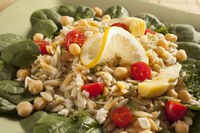Prairie Fare: Be Inspired by the Mediterranean Diet
(Click an image below to view a high-resolution image that can be downloaded)
By Julie Garden-Robinson, Food and Nutrition Specialist
NDSU Extension
“I’ll have falafel in my pita,” my son said to the foodservice worker.
We were at a Mediterranean restaurant in downtown Minneapolis.
“Do you know what falafel is?” I asked him.
He grinned at me and nodded. I could almost read his mind.
My big-city guy was putting up with his small-town mother.
I had a flashback of his daycare provider’s note. She was concerned about his picky eating behavior. He only wanted macaroni and cheese and applesauce back in the day.
He certainly developed an adventuresome palate.
Falafel, by the way, is made from chickpeas, which are also known as garbanzo beans. To make falafel, cooked or canned chickpeas are mashed or processed in a food processor. Then they are blended with chopped onions, herbs, spices and often, baking soda and chickpea flour. The mixture is formed into patties or small balls and then fried. Avocado oil sometimes is used as the frying oil due to its heat stability.
My husband and I had whole-grain pita bread stuffed with seasoned beef, chopped red cabbage, cucumber, avocado and hummus (also made from chickpeas).
I watched the chef make our sandwiches. Frankly, I was a little leery of this flavor combination. I was pleasantly surprised. We all felt as stuffed as our pita bread after a big dose of flavorful fiber.
Chickpeas and other pulse foods, such as lentils and split peas, are notable sources of fiber and the B vitamin folate.
Eating a Mediterranean-inspired diet is particularly healthful. In fact, the Mediterranean Diet has occupied the first or second spot on “healthiest diet” lists for several years.
The Mediterranean eating style is embraced by 22 countries near the Mediterranean Sea, including Greece, Spain, southern France and Italy.
The Mediterranean diet is rich in vegetables, fruits, whole grains, healthful fats and lowfat dairy. In particular, the eating pattern usually incorporates at least one to two servings of whole grain foods at each meal, two servings of vegetables at lunch and dinner and one to two servings of fruit at each meal. Fruit often is served as a dessert.
It is rich in beans, nuts, seeds, fish and seafood. It includes dairy, poultry and lean meat.
If this sounds familiar, be aware that the U.S. Dietary Guidelines for Americans and MyPlate (at www.choosemyplate.gov) have similarities to the Mediterranean Diet.
Vegetables and fruits are particularly high in antioxidant nutrients such as vitamins A and C, and carotenoids such as beta-carotene and lycopene. Antioxidants serve as our “internal boxing gloves.” These natural chemicals in foods help our bodies fight damage to the cells of our body from smoke, pollution and other stressors on our bodies.
Although it is called a “diet,” the Mediterranean diet is not necessarily for weight loss. However, filling up on vegetables, fruits and whole grains may help with weight maintenance or loss.
Eating healthfully can reduce your risk for chronic disease. Several positive health outcomes are associated with following the Mediterranean diet. Some researchers have noted fewer heart attacks and strokes, better blood glucose control for those with diabetes and a reduction in the risk for certain types of cancer.
Some researchers also have linked following a Mediterranean diet with reducing risk for depression and Alzheimer’s disease.
Here’s a colorful Mediterranean diet-inspired salad recipe. Try it as a side dish with broiled salmon. See “On the Pulse of Healthful Eating” from NDSU Extension for 15 pulse recipes. This publication is available at https://www.ag.ndsu.edu/publications/food-nutrition/on-the-pulse-of-healthful-eating-using-more-pulse-foods-in-your-diet.
Orzo Salad with Chickpeas and Artichoke Hearts
1/2 cup orzo or other tiny pasta
2 teaspoons extra virgin olive oil
1 clove garlic, peeled and crushed
1/8 teaspoon salt
1/8 teaspoon ground pepper
1 1/2 teaspoon lemon juice
1 (14-ounce) can of artichoke hearts, drained and chopped
1 (15-ounce) can of chickpeas, drained and rinsed
1/3 cup crumbled feta cheese
2 tablespoons fresh dill, chopped
1 1/2 tablespoons fresh mint, chopped
1 large tomato, chopped
6 cups baby spinach
Bring a small saucepan of water to a boil. Cook orzo until just tender, about nine minutes, or according to package directions. Drain water and allow to cool. Transfer to a medium bowl and toss with oil. Mash garlic and salt into a paste with the back of a spoon in a medium bowl. Whisk in lemon juice and pepper. Add the cooked orzo, artichokes, chickpeas, feta, dill and mint; toss gently to combine. Add tomatoes and toss again. Serve on top of fresh spinach. If making ahead of time, wait to add tomatoes and spinach until right before serving.
Makes six servings (1 cup per serving). Each serving has 220 calories, 6 grams (g) of fat, 10 g of protein, 36 g of carbohydrate, 8 g of fiber and 560 milligrams (mg) of sodium.
(Julie Garden-Robinson, Ph.D., R.D., L.R.D., is a North Dakota State University Extension food and nutrition specialist and professor in the Department of Health, Nutrition and Exercise Sciences. Follow her on Twitter @jgardenrobinson)
NDSU Agriculture Communication – Dec. 16, 2021
Source: Julie Garden-Robinson, 701-231-7187, julie.garden-robinson@ndsu.edu
Editor: Kelli Anderson, 701-231-6136. kelli.c.anderson@ndsu.edu




